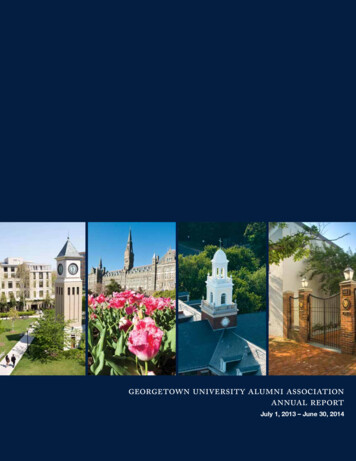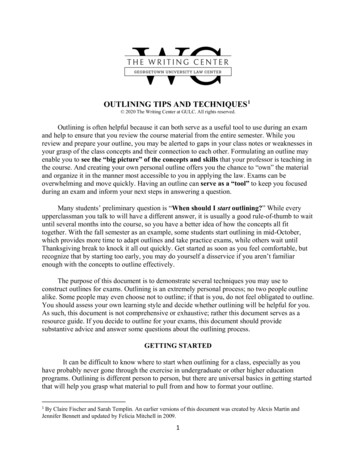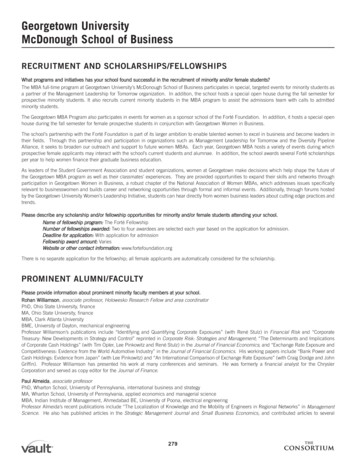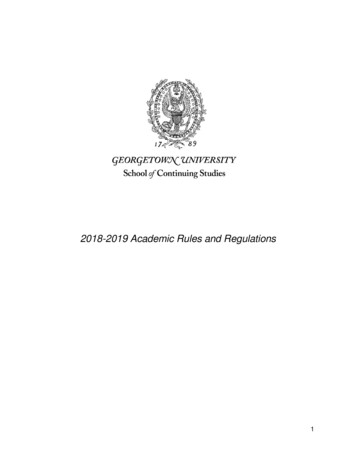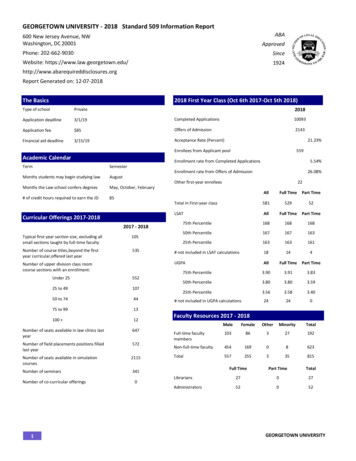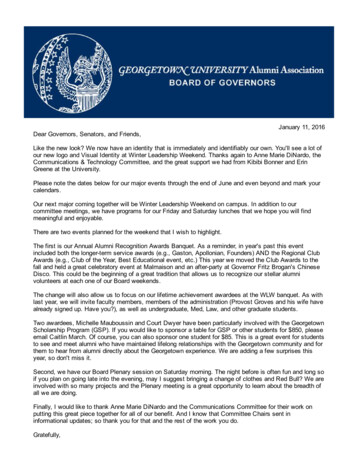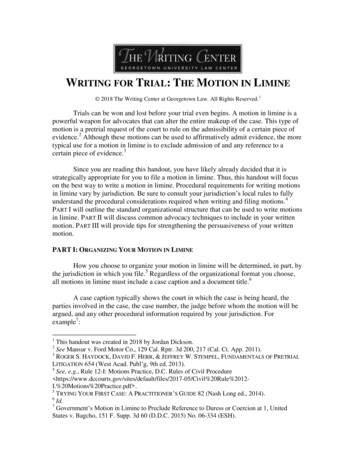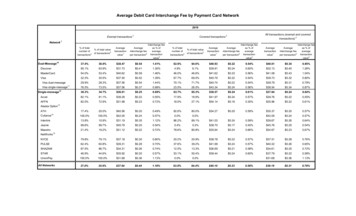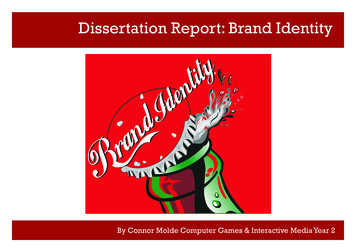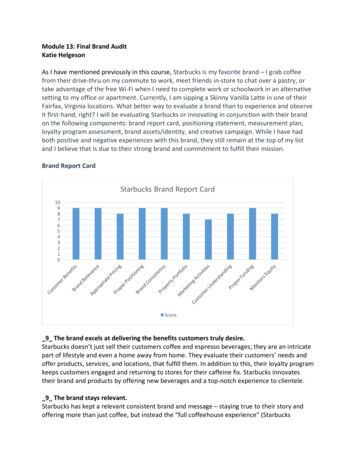
Transcription
Module 13: Final Brand AuditKatie HelgesonAs I have mentioned previously in this course, Starbucks is my favorite brand – I grab coffeefrom their drive-thru on my commute to work, meet friends in-store to chat over a pastry, ortake advantage of the free Wi-Fi when I need to complete work or schoolwork in an alternativesetting to my office or apartment. Currently, I am sipping a Skinny Vanilla Latte in one of theirFairfax, Virginia locations. What better way to evaluate a brand than to experience and observeit first-hand, right? I will be evaluating Starbucks or innovating in conjunction with their brandon the following components: brand report card, positioning statement, measurement plan,loyalty program assessment, brand assets/identity, and creative campaign. While I have hadboth positive and negative experiences with this brand, they still remain at the top of my listand I believe that is due to their strong brand and commitment to fulfill their mission.Brand Report CardStarbucks Brand Report Card109876543210Score9 The brand excels at delivering the benefits customers truly desire.Starbucks doesn’t just sell their customers coffee and espresso beverages; they are an intricatepart of lifestyle and even a home away from home. They evaluate their customers’ needs andoffer products, services, and locations, that fulfill them. In addition to this, their loyalty programkeeps customers engaged and returning to stores for their caffeine fix. Starbucks innovatestheir brand and products by offering new beverages and a top-notch experience to clientele.9 The brand stays relevant.Starbucks has kept a relevant consistent brand and message – staying true to their story andoffering more than just coffee, but instead the “full coffeehouse experience” (Starbucks
Company Information). They continue to innovate by offering new products in addition to theirloved, known favorites. They want to be part of their customers’ routines, social and work lives,and communities, and are constantly innovating to stay at the forefront of the coffeeexperience. They keep their look consistent and are well recognized across the world. Peopleare always going to want coffee – and Starbucks ensures they will always want their coffee.8 The pricing strategy is based on consumers’ perceptions of value.While many consider Starbucks’ pricing to be high, they still purchase their products becausethey trust the brand, quality, and consistency. Many competitors, like Dunkin’ Donuts, offerlower prices, but Starbucks still dominates the market due to product quality and essentiallybeing a status symbol. Customers are aware of their pricing, but they continue to come back forthe experience, the product, and the status symbol.9 The brand is properly positioned.Starbucks is positioned well against competitors. Aspects that make them stand out are: theircountless locations, their perception of being a status symbol, and their brand and productconsistency. They offer exceptional customer service and loyalty. Competitors may have lowerprices, but Starbucks still prevails.9 The brand is consistent.The Starbucks’ brand has been consistent in messaging, branding, and in their product.Customers know that regardless of what location they visit, they will have a good experienceand a tasty beverage. There aren’t surprises with the Starbucks brand. Customers will noticesigns throughout the store (and on their classic white cup) that say: “Love your beverage or letus know. We’ll always make it right.”8 The brand portfolio and hierarchy make sense.Starbucks markets their various beverages and retail items, of various price points,appropriately. They know that not everyone can afford a 5-dollar latte or wants one daily –some just want a basic cup of coffee, tea, or shot of espresso. Starbucks understands that someof their customers prefer to make their beverages at home, but need the equipment andsupplies to do so. Their message is consistent across the various products they market, and theydo a good job of realizing who their target audience is for each.7 The brand makes use of and coordinates a full repertoire of marketing activities to buildequity.Starbucks markets in television, print, social media, and other platforms. However, theirproducts do not require them to market excessively, as they can build off of their brand loyaltyand recognition. They primarily rely on word-of-mouth advertising and customer loyalty.8 The brand’s managers understand what the brand means to consumers.The brand managers understand that Starbucks isn’t just a place to get coffee. It is a meetingspot or a place to get work done while enjoying an exceptional product. They capitalize on their
product being part of a lifestyle. Customers feel very strongly about the brand and this helpsthe brand managers better serve them.9 The brand is given proper support, and that support is sustained over the long run.Starbucks is given the support and equity needed to be successful and maintain theirprestigious place in the market. While I haven’t found concrete evidence of this, it is clear basedon their prominence.8 The company monitors sources of brand equity.Starbucks is constantly monitoring brand equity. They value being a great brand and want tobest serve their customer. They monitor their presence against other companies and continueto innovate.Positioning StatementStarbucks has the following mission statement, as published on their website: “To inspire andnurture the human spirit – one person, one cup and one neighborhood at a time.”Taking this mission into account in conjunction with additional evaluation of their brand, Icreated the following positioning statement for Starbucks: For coffee and tea lovers, who valuecommunity, customization, and consistency, Starbucks is your home away from home, whereyou can relax, gather, or grab and go, the finest coffee in many beverage forms to revive yourspirit and consume responsibly. Starbucks is your coffee destination that can be found virtuallyanywhere, but still gives you a friendly neighborhood vibe whether you are a regular or justpassing through.I believe this positioning statement captures the company and brand’s vision – to not just be aplace to grab a coffee, but instead, a community gathering place that strives to improve theworld and the individuals that consume it.Measurement PlanI believe that Starbuck’s measurement plan should include the following: brand awareness(quantitative), brand recognition (quantitative), social listening (qualitative), focus groups(qualitative), surveys (quantitative), and analysis of overall business measures like sales andenvironmental footprint. These aspects are important in making sure they are fulfilling thecustomer and community’s expectations for the brand – while still meeting their sales andbusiness goals.By surveying their customers, which is something they already do, they can hone in on differentlocations and their opportunities for improvement. These surveys can ensure that all Starbuckslocations are being held to the same standards and fulfilling them accordingly.ArchetypeStarbucks is typically defined as possessing the Explorer archetype. Their brand’s roots andname are based strongly on this archetype – the desire to find yourself through exploration,
experiencing new things, and having a fulfilling life. While the brand fulfills these categories, Ifind it interesting that the greatest fear of this archetype is conforming. Starbucks can beviewed as basic, mainstream, etc. by the general public. However, I still believe this is the bestarchetype fit for the brand. I also see bits of the “Every Person” archetype in the Starbucksbrand – as they encourage community, connections with others, etc.On their website, Starbucks states that the brand wishes to accomplish 2 things: “share greatcoffee with their friends and make the world a little better.” The first Starbucks opened in 1971in Seattle, Washington. The solo coffee shop prided themselves on offering fresh-roasted,whole bean coffees. The Starbucks name was inspired by Moby Dick, and looked to capture theessence of the seafaring ways of coffee traders. The CEO of Starbucks, Howard Schultz, lovedthe roots of the company and the taste of their coffee, but after a trip to Italy and visiting theircoffee shops – wanted to bring that feeling of community back to the United States. The basisof a great product with the idea of forming a central gathering location where customers felt athome turned into a coffee monster.Loyalty Program AssessmentStarbucks revamped their rewards program in 2016 – a controversial transition to say the least.The company has gone from calculating rewards from number of items purchased to number ofdollars spent using their Starbucks app, which houses and manages their rewards program. Forevery 1 spent using the Starbucks app, members receive 2 stars. Once a member earns 125stars, they are able to redeem those stars for a free food or drink item of their choice. Thisequates to 62.50 spent before receiving a reward. The ultimate goal of the Starbucks app, is toreach “gold status,” which is achieved by earning 300 stars in a period of 12-months. At thislevel, members receive a personalized gold card and additional membership perks like a freeitem on their birthday, free basic coffee and tea refills, and more.Starbucks customers love the ease and experience that accompany their visits. The rewardsprogram only adds to that – they can easily pay, reload payment, and track their progresstoward rewards all in one application. There is no guesswork – they know where they stand andabove all else: it makes their life easier by saving them time and gives back to them for theirfrequent, often daily, visits to get their caffeine fix.The rewards program allows for customer engagement – within the app where the loyaltyprogram is housed is also an area to locate the nearest stores, send a gift, order ahead, andlisten to music. Starbucks can also send customers messages through the app to let them knowwhen they can earn extra rewards – by purchasing a specific item based on the day or week’spromotions or for coming in-store at a certain day/time. They also have fun games, likeStarbucks bingo, where users can earn additional rewards.While having a Smartphone is almost a given these days, not everyone has one – the rewardsprogram is virtually impossible to manage without one. While members could use a computerand a gift card to avoid this, it takes away from one of the app’s greatest benefits –convenience. The rewards program allows a visit to be more efficient – scanning payment is
much faster than using a credit card or paying with cash, keeping everyone happy. When areward is ready to be redeemed, it is a big treat for Starbuck’s clientele. They can get whateverthey want! It feels like a special day getting a larger drink or an extra shot of espresso for free.Dunkin Donuts, one of Starbucks leading competitors, has a similar loyalty program called DDPerks. Their program is also housed on a phone app and allows members to get a free beveragefor every 200 points earned, which ends up being about 40 worth of purchases. I believe this isa similar program, given the cost differential between the two stores and their products.Starbucks, unlike Dunkin Donuts, allows points to be redeemed on food items like breakfastsandwiches or pastries. Pete’s Coffee is slowly rolling out a rewards program, but is notavailable everywhere yet.As a regular user of the Starbucks rewards program, I think I would change rewards expiring –this is a big complaint by customers. If you have earned a reward, you’ve earned it. It shouldnot get taken away because you haven’t used it in a timely manner.Brand Assets/IdentityStarbucks has strong brand assets and identity. While they don’t have an official slogan, theyhave used the following throughout their existence: the best coffee for the best you; it’s biggerthan coffee, and uniquely Starbucks. Their logo represents their archetype well and reliesheavily on their roots – you will find the logo on their packaging, in-store products (napkins,cups), and on their advertising. It is easily recognizable without any text and serves the brandwell. Their packaging gives an earthy feel, which ties back into their mission of beingenvironmentally responsible. Overall, I believe these items together, create a strong brandidentity for Starbucks that measures well in relation to the course’s evaluation criteria for brandassets and identity.Recent Creative CampaignStarbucks does not rely heavily on advertising – they are mostly known for word-of-mouthadvertising. The most recent creative campaign from Starbucks is their unicorn Frappuccino, alimited-time product with corresponding creative content like in-store signs, social media posts,e-mail messaging, and subsequently a lot of external press and social media action – both goodand bad. This item sparked a social media revolution – through a fairly simple campaign, lettingcustomers know on the Starbucks app, through the press, and through creative in-store signagewith corresponding colorful pictures. It is the perfect example of how Starbucks relies on wordof-mouth advertising to maintain their position as a strong brand.This campaign targeted millennial-aged women, not their customer audience as a whole. Theyintended for this product to spike social media chatter and customer engagement. What theydidn’t know, was all the press they would receive – talking about the sugar content incomparison to other beverages, etc. While the unicorn Frappuccino certainly isn’t for everyone,I believe it was appropriate for the brand and fit well within their archetype – encouragingpeople to step outside of the box, be adventurous, and live life to the fullest. They bring aunique twist to their popular frozen beverage and encourage their customers to mix it up.
Additionally, with all of the so
are always going to want coffee – and Starbucks ensures they will always want their coffee. _8_ The pricing strategy is based on consumers’ perceptions of value. While many consider Starbucks’ pricing to be high, they still purchase their products because they trust the brand, quality, and consistency. Many competitors, like Dunkin’ Donuts, offer
